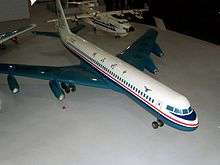Shanghai Y-10
| Y-10 运-10 | |
|---|---|
 | |
| Role | Narrow-body jet airliner |
| Manufacturer | Shanghai Aircraft Manufacture Factory |
| Designer | Shanghai Aircraft Research Institute[1] |
| First flight | 26 September 1980[1] |
| Number built | 3 |



The Shanghai Y-10 (Y represents the first letter of pinyin of Transporter in Chinese: Yunshuji 运输机) was a four engined narrow-body jet airliner developed in the 1970s by the Shanghai Aircraft Research Institute. The plane used Boeing's B707-320C as reference, designed according to Federal Aviation Regulation (Part 25, 1970 edition).[2]
Due to unavailability of the intended WS-8 turbofan engines the prototype aircraft used Pratt & Whitney JT3D-7 turbofan engines, acquired as spare engines for CAAC's small fleet of Boeing 707 aircraft. The cabin could be configured to seat 178 in high-density, 149 in economy, or 124 in mixed-class and the large flight deck accommodated five crew members: pilot, co-pilot, flight engineer, navigator, and radio operator.[1]
History
Development work, given code name 708, began in Shanghai in August, 1970 for Civil Aviation Administration of China (CAAC). The plane was intended to serve as a demonstrator and help the Chinese industry obtain experience in large aircraft design and flight testing. The Y-10 development costs totalled 537.7 million yuan. The Chinese government prided itself on the program, citing a Reuters report which said, "After developing this kind of highly complex technology, one could no longer regard China as a backward country." [3]The project was heavily tainted by politics from the beginning because it was spearheaded by Wang Hongwen, one of the Gang of Four. The strategic vision of an independently developed large transport plane had long been voiced by Mao Zedong and, in 2006, a similar project with updated design goals made its way into the Eleventh Five-Year Plan, periodic strategic socio-economical development plans drawn up by the Chinese government.[1] The general designer of Y-10 is Mr. Ma Fengshan (马凤山).
Three aircraft were built by the Shanghai Aircraft Factory, (now known as Shanghai Aviation Industrial Company, or SAIC) at Dachang Air Base north of Shangai. The first prototype (01) was used for static testing, the second prototype (02) was used for flight testing and the third (03) for fatigue testing. The plane first flew on September 26, 1980, making 130 flights with 170 hours of flying time, visiting Beijing, Harbin, Urumqi, Zhengzhou, Hefei, Guangzhou, Kunming, Lhasa and Chengdu before its retirement in 1984.[1]
The Y-10 is an indigenous Chinese design.[4] In 1970, the factory got a Pakistan Boeing 707 crashed in Hetian, Xinjiang to study it.[5] While the planes were reverse-engineered copies of the Boeing 707—one report claimed that after Chinese engineers disassembled a 707 to study it, neither the reassembled original nor the copy would fly[6]—both the Y-10's designers and Boeing denied this. While the Y-10 resembles the 707, its dimensions are closer to the Boeing 720 than the 707, and the internal design is very different.[4]
By the time the prototype was first flown, debate about its viability surfaced, based on a design that was already 30 years old, CAAC, which already owned a modest Western fleet, would not purchase the plane. China was beginning to embrace trade with the West, and some saw the isolationist design as an inefficient throwback to Maoism. China in the early reform era was ruled by rehabilitated cadres previously persecuted in the Cultural Revolution by Wang Hongwen, the project initiator, resulting in the cancellation of the project in 1983, officially due to cost and market concerns. During its maiden flights, no governmental officials attended the ceremonies for fear of the connection to Wang Hongwen and the Gang of Four. By 1985, SAMF had been granted production licensing for the McDonnell Douglas MD-80 and shifted all efforts towards that program.
A model of an AWACS variant has been seen, resembling the Boeing E-3 Sentry AWACS aircraft.[1]
- Panels
 Overhead
Overhead

Specifications (Y-10)
Data from
General characteristics
- Crew: 5 (pilot, co-pilot, flight engineer, navigator, radio operator)
- Capacity: up to 178 passengers
- Length: 42.93 m (140 ft 10 in)
- Wingspan: 42.24 m (138 ft 7 in)
- Height: 13.42 m (44 ft 0 in)
- Wing area: 244.5 m² (2,632 ft²)
- Empty weight: 58,120 kg (127,865 lb)
- Max. takeoff weight: 110,227 kg (242,500 lb)
- Powerplant: 4 × Pratt & Whitney JT3D-3B turbofan, 84.7 kN (19,000 lbf) each
Performance
- Maximum speed: 639 km/h (399 mph)
- Range: 8,300 km (5,188 miles)
- Service ceiling: 12,000 m (39,370 ft)
- Thrust/weight: 0.313
See also
Aircraft of comparable role, configuration and era
- Convair 880
- Convair 990
- Douglas DC-8
- Boeing 707-120 series
- Boeing 720B
Related lists
References
- 1 2 3 4 5 6 Gordon,Yefim & Komissarov, Dmitry. Chinese Aircraft. Hikoki Publications. Manchester. 2008. ISBN 978-1-902109-04-6
- ↑ 上海民用航空产业发展研究,P7, ISBN 978 7 313 09555 8
- ↑ "航空工业六十年:从运十到COMAC919". 民航资源网. September 27, 2009. Retrieved August 10, 2017.
路透社评论:“在得到这种高度复杂的技术时,再也不能视中国为一个落后国家了。”
- 1 2 "Y-10". globalsecurity.org. Retrieved September 7, 2011.
- ↑ 运-10研制经纬谈.
- ↑ Crane, David (March–April 1981). "The Harrier Jump-Jet and Sino-British Relations". Asian Affairs. 8 (4): 227–250. doi:10.1080/00927678.1981.10553811. JSTOR 30173489.
Further reading
Taylor, W. R. (Ed.). Jane's All the World's Aircraft, 1980-81. (London: Jane's Publishing Company), pp. 40 ff.
External links
External links
| Wikimedia Commons has media related to Shanghai Y-10. |